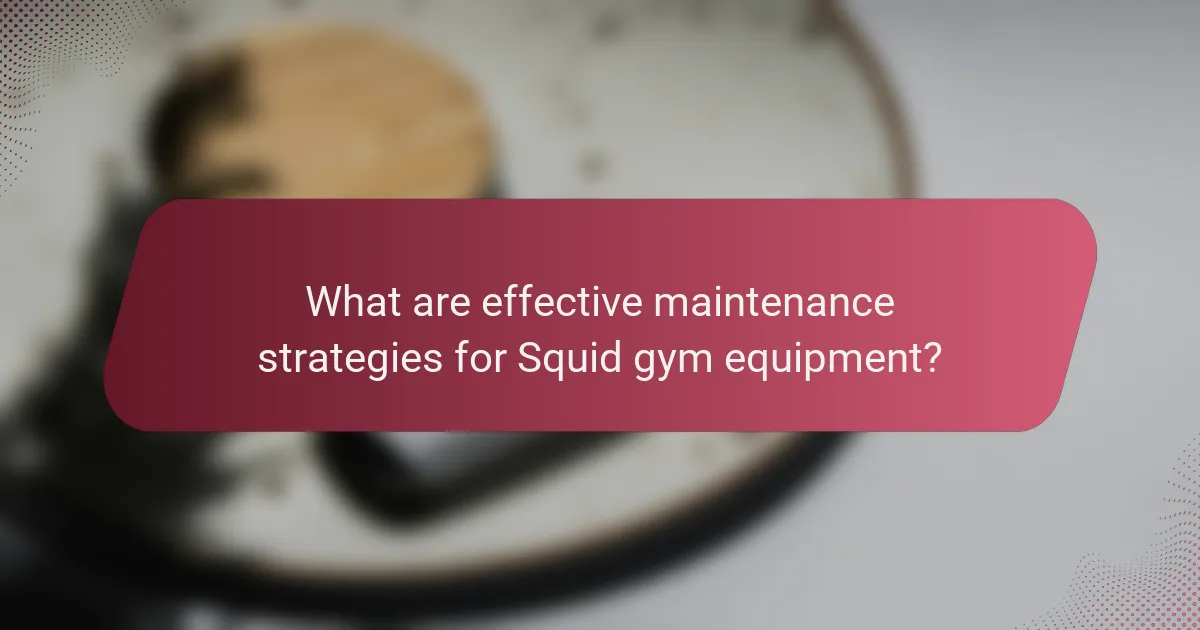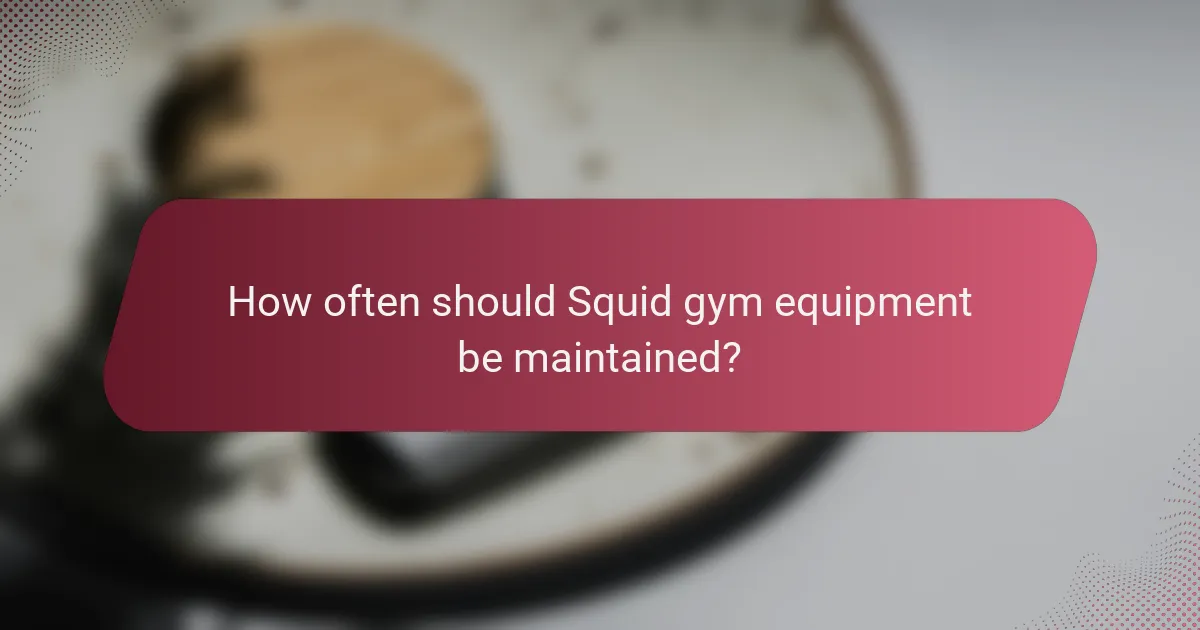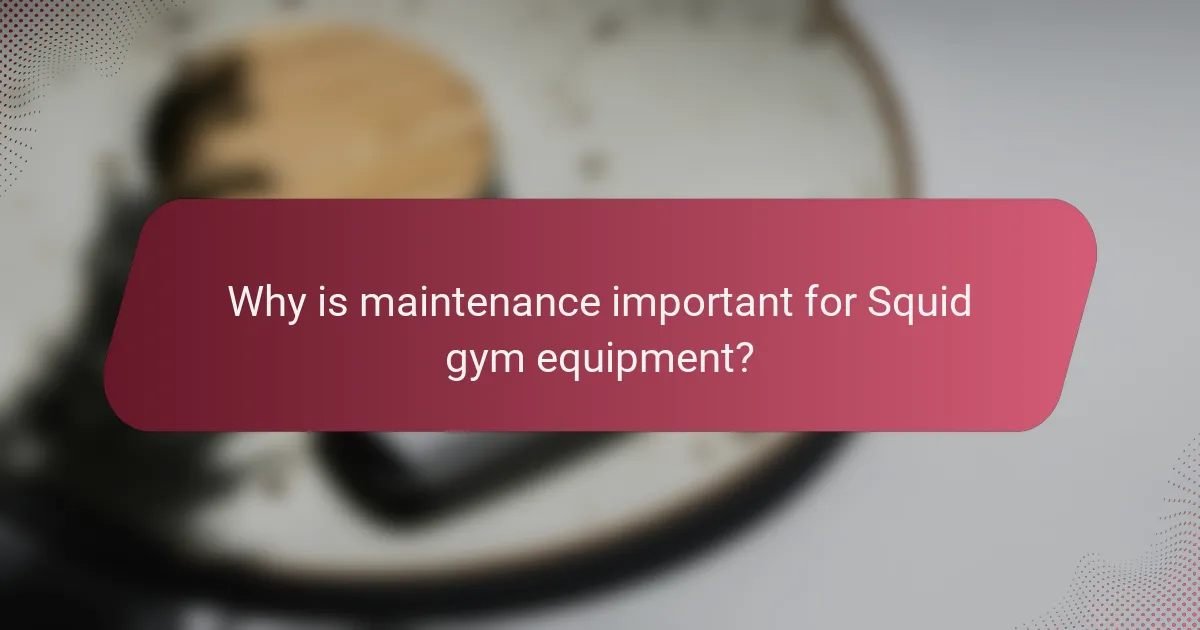Maintaining Squid gym equipment is essential for ensuring safety, performance, and longevity. Implementing effective strategies such as regular cleaning, lubrication, and scheduled inspections can significantly enhance the user experience while minimizing repair costs. Establishing a structured maintenance schedule tailored to usage frequency is crucial for optimal equipment reliability.

What are effective maintenance strategies for Squid gym equipment?
Effective maintenance strategies for Squid gym equipment include regular cleaning, proper lubrication, scheduled inspections, timely parts replacement, and staff training. These practices ensure equipment longevity, safety, and optimal performance, ultimately enhancing the user experience.
Regular cleaning protocols
Implementing regular cleaning protocols is essential to maintain Squid gym equipment. Wipe down surfaces after each use to remove sweat and grime, using appropriate cleaning solutions that won’t damage the equipment’s finish. Establish a daily or weekly deep cleaning schedule to ensure all machines are thoroughly sanitized.
Consider using microfiber cloths and non-abrasive cleaners to avoid scratches. Additionally, create a checklist for staff to follow, ensuring no area is overlooked during cleaning sessions.
Lubrication techniques
Proper lubrication is crucial for the smooth operation of moving parts in Squid gym equipment. Use manufacturer-recommended lubricants and apply them according to the equipment’s specific requirements. Generally, lubricating the moving parts every few weeks can prevent wear and tear.
Pay attention to high-friction areas such as cables and pulleys. A simple rule is to check lubrication levels during each inspection and apply as needed, ensuring that the equipment operates quietly and efficiently.
Inspection schedules
Establishing a regular inspection schedule helps identify potential issues before they escalate. Inspections should occur at least once a month, focusing on key components such as cables, belts, and electronic systems. Document findings and address any repairs promptly to maintain safety standards.
Utilize a checklist during inspections to ensure all critical areas are covered. This proactive approach can significantly reduce downtime and repair costs over time.
Parts replacement guidelines
Timely parts replacement is vital for the safety and functionality of Squid gym equipment. Monitor wear indicators and replace parts like cables, grips, and pads as they show signs of deterioration. Following the manufacturer’s guidelines for replacement intervals can help maintain optimal performance.
Keep a stock of commonly replaced parts on hand to minimize downtime. Educate staff on recognizing when parts need replacement to ensure quick action is taken.
Training staff on maintenance
Training staff on maintenance practices is essential for the effective upkeep of Squid gym equipment. Provide comprehensive training sessions that cover cleaning, lubrication, inspections, and parts replacement. Empower staff with knowledge to identify issues and perform basic maintenance tasks.
Regular refresher courses can help keep staff updated on best practices and any new equipment features. Creating a culture of maintenance awareness among staff will enhance the overall safety and performance of the gym equipment.

How often should Squid gym equipment be maintained?
Squid gym equipment should be maintained regularly to ensure safety and optimal performance. Maintenance frequency varies based on usage, but a structured schedule of daily, weekly, monthly, and annual tasks is essential for longevity and reliability.
Daily maintenance tasks
Daily maintenance tasks are crucial for keeping Squid gym equipment in top condition. This includes wiping down surfaces to remove sweat and grime, checking for any visible damage, and ensuring that all moving parts are functioning smoothly.
Additionally, inspect cables and pulleys for wear and tear. A quick visual check can prevent larger issues down the line and ensure a safe workout environment.
Weekly inspection routines
Weekly inspections should focus on more detailed checks of equipment functionality. This includes testing the calibration of machines, tightening loose bolts, and lubricating moving parts as needed to prevent friction and wear.
Consider creating a checklist for these inspections to ensure no aspect is overlooked. Regular weekly checks can help identify potential problems before they escalate.
Monthly deep cleaning
Monthly deep cleaning involves a thorough cleaning of all gym equipment. This includes disassembling parts where necessary to clean hard-to-reach areas and using appropriate cleaning agents that won’t damage the equipment.
Pay special attention to areas that accumulate dust and debris, such as under the machines and around weights. A clean environment not only enhances equipment longevity but also promotes a healthier workout space.
Annual professional servicing
Annual professional servicing is essential for comprehensive maintenance of Squid gym equipment. This service typically includes a complete inspection, calibration, and repair of any worn components by certified technicians.
Investing in professional servicing can help ensure that equipment meets safety standards and operates efficiently. It is advisable to schedule this service during off-peak times to minimize disruption to gym operations.

Why is maintenance important for Squid gym equipment?
Maintenance is crucial for Squid gym equipment to ensure its longevity, safety, and performance. Regular upkeep not only extends the lifespan of the equipment but also enhances user experience and reduces unexpected repair costs.
Enhances equipment lifespan
Regular maintenance significantly enhances the lifespan of Squid gym equipment. By routinely checking and servicing components, potential issues can be identified and resolved before they lead to major failures. This proactive approach can extend the functional life of machines by several years.
For example, lubricating moving parts and tightening bolts can prevent wear and tear. Establishing a maintenance schedule every few months can help keep equipment in optimal condition.
Improves user safety
Safety is paramount in any gym setting, and well-maintained Squid equipment plays a vital role in ensuring user safety. Regular inspections can identify hazards such as frayed cables or loose components that could lead to accidents.
Implementing a checklist for safety inspections before each use can help catch issues early. This practice not only protects users but also fosters a culture of safety within the gym environment.
Reduces repair costs
Consistent maintenance can significantly reduce repair costs associated with Squid gym equipment. By addressing minor issues promptly, gym owners can avoid costly repairs that arise from neglecting routine care.
For instance, replacing a worn belt is far less expensive than repairing a damaged motor caused by that belt’s failure. Keeping a log of maintenance activities can help track costs and identify patterns that may require attention.
Maintains performance standards
Regular maintenance ensures that Squid gym equipment operates at peak performance standards. Equipment that is well cared for provides consistent results, which is essential for user satisfaction and retention.
To maintain performance, consider calibrating machines and replacing worn parts as needed. Setting performance benchmarks and regularly testing equipment can help ensure that it meets user expectations and industry standards.

What tools are needed for Squid gym equipment maintenance?
To maintain Squid gym equipment effectively, you need a variety of tools that ensure cleanliness, functionality, and longevity. Essential tools include cleaning supplies, lubricants, basic repair tools, and diagnostic equipment.
Cleaning supplies
Cleaning supplies are crucial for maintaining hygiene and performance in gym equipment. Common items include disinfectant wipes, mild detergents, and microfiber cloths that effectively remove dirt and sweat without damaging surfaces.
Regular cleaning should be part of your maintenance routine, ideally after each use or at least daily. This helps prevent the buildup of grime and bacteria, ensuring a safe workout environment.
Lubricants
Lubricants are essential for keeping moving parts of gym equipment functioning smoothly. Options such as silicone spray or lithium grease can reduce friction and wear on components like cables, pulleys, and bearings.
Apply lubricants according to the manufacturer’s recommendations, typically every few months or when you notice any unusual noises or resistance during operation. Proper lubrication extends the lifespan of your equipment.
Basic repair tools
Basic repair tools are necessary for minor fixes and adjustments. A set of wrenches, screwdrivers, and pliers can handle most common issues that arise with gym equipment.
Having these tools on hand allows for quick repairs, which can prevent larger problems and downtime. Regularly check equipment for loose bolts or worn parts, and address these issues promptly.
Diagnostic equipment
Diagnostic equipment helps identify issues with gym machines before they become serious problems. Tools like multimeters and tension gauges can assess electrical components and cable tension, respectively.
Using diagnostic tools regularly can save time and money by catching potential failures early. Consider incorporating these checks into your maintenance schedule to ensure optimal performance and safety.

What are the prerequisites for maintaining Squid gym equipment?
To effectively maintain Squid gym equipment, it’s essential to have a basic understanding of the equipment’s components and recommended maintenance practices. This knowledge ensures that the equipment remains in optimal working condition, prolonging its lifespan and enhancing user safety.
Understanding the Equipment
Familiarize yourself with the specific Squid gym equipment you own, including its parts, functions, and any unique features. Each piece may have different maintenance requirements based on its design and usage frequency. Reviewing the manufacturer’s manual can provide valuable insights into what to monitor and how to care for each item.
Pay attention to common components such as cables, pulleys, and resistance mechanisms, as these are often the most prone to wear and tear. Regularly inspect these parts for signs of damage or excessive wear to prevent malfunctions.
Regular Inspection Schedule
Establish a routine inspection schedule to assess the condition of your Squid gym equipment. A good practice is to conduct these inspections weekly for high-use items and monthly for less frequently used equipment. This helps identify issues early, allowing for timely repairs and maintenance.
During inspections, check for loose bolts, frayed cables, and any unusual noises during operation. Keeping a maintenance log can help track inspection dates and any repairs performed, ensuring nothing is overlooked.
Cleaning and Lubrication
Regular cleaning and lubrication are crucial for maintaining Squid gym equipment. Use a mild detergent and a soft cloth to wipe down surfaces, removing sweat and grime that can lead to corrosion. Avoid harsh chemicals that could damage the equipment’s finish.
Lubricate moving parts as recommended by the manufacturer, typically every few months or after heavy use. This reduces friction and wear, ensuring smooth operation. Use appropriate lubricants, such as silicone spray or specific oils, to maintain performance.
Replacement of Worn Parts
Be proactive about replacing worn or damaged parts to maintain the safety and functionality of your Squid gym equipment. Commonly replaced items include cables, grips, and pads, which can wear out over time. Keep a stock of essential replacement parts on hand to minimize downtime.
Consult the manufacturer’s guidelines for recommended replacement intervals and procedures. If unsure, seeking professional assistance for repairs can help ensure that replacements are done correctly and safely.
